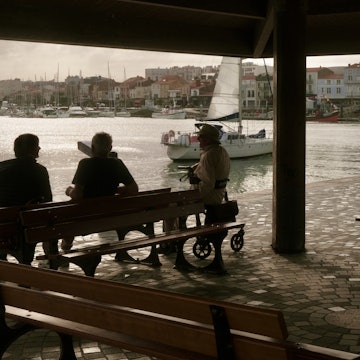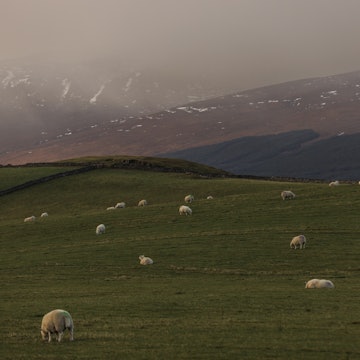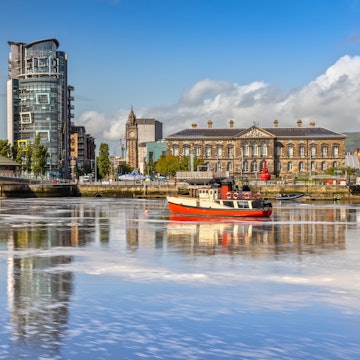
A beginner's guide to Scottish whisky: history, regions, trails – and the best places to enjoy a drop

Aug 5, 2022 • 7 min read

Scotland’s whisky is a unique fusion of geography and history developed over time © Getty Images / iStockphoto
The Gaelic term for whisky − uisge beatha, or "water of life" − illustrates how intrinsically linked the drink is to Scottish culture. Scotland’s whisky is a unique fusion of geography and history developed over time, in conditions that mean no other whiskies can compete in terms of pedigree, character and diversity of spirits produced.
What other national drink could boast a past featuring adventuring monks, experimental kings and a famous poet? What other country’s tipple could reflect a topography of peaty moors, heathery glens and briny ocean? Here's what makes Scottish whisky so special.
History of Scottish whisky
It was likely those masters of alcohol manufacture, monks, who can be credited with first distilling whisky in Scotland. As monasticism spread north from continental Europe in the 11th century, so too did the holy men’s winemaking expertise: Scotland’s climate prevented grapes from flourishing, yet grains still did fine.
The earliest documentation of Scottish whisky-making in 1494 has a friar as the distiller. Scotland’s King James IV (1488–1513) was the first to famously appreciate aqua vitae, although for its usefulness as a component in gunpowder as much as its taste, which in those days would have been strong, rough and devoid of the maturation giving whisky such flavor today.
Still, whisky grew in popularity, and Scotland's parliament soon wanted to capitalize. The first payments of duty on strong spirits were levied in 1644 but were notoriously unfair. Consequently, whisky-making was driven underground, made in makeshift stills in remote locations far from the law’s reach and transported by smugglers in order to evade those taxes.
Meanwhile, excisemen, including national bard Robert Burns in the late 18th century, attempted the difficult task of ensuring errant distillers paid their dues. Tensions between the two sides of the distilling business ran high, and many resources were wasted all around. Parliament changed tack, passing legislation to make legal whisky production more attractive for distillers, and in 1824 George Smith became the first distiller to take out a license under the new laws, founding Glenlivet Distillery.
Whisky’s cavalier days were over; now the focus was on making the spirit in big quantities not possible in the drink’s cottage-industry days. Invention of the column still increased capacity, and when the phylloxera parasite destroyed France’s vineyards in 1880, demand for whisky increased as wine, cognac and brandy floundered.
Whisky’s cachet outside Scotland was now growing, but only the 20th century has seen it become the high-standard spirit it is today. Teetotaling British Prime Minister David Lloyd George passed the Immature Spirits Act in 1915, rendering maturation for at least two years obligatory and markedly improving whisky’s flavor.
In the 1950s, single malt whisky, a product synonymous with quality in contrast to the blends and grain whiskies that had dominated the market until that point, began to be properly branded. Since then, Scotland’s single malt whisky has been at the pinnacle of world spirits, not just for its charismatic history but for its quality too, offering whisky connoisseurs a flavor palette and complexity unrivaled anywhere else.
What sets single malt Scottish whisky apart?
All whisky-making begins with the steeping of grain in water; Scottish single malts use only quality malted barley and spring water renowned for its purity. Single malt whisky is typically double-distilled in copper-pot stills, which create many more congeners than column-still distillation, and therefore more complex tastes.
Distillation also happens at less than 94.8 ABV, meaning alcohol has no chance to trample over the flavor and aroma of the natural core ingredients. Maturation happens for at least three years – and often decades more besides – in oak barrels; this is when a single malt’s rich final flavor is mainly imparted.
Scotland’s geography is one of great contrasts packed together within a relatively small area, and this exerts a special character on the country’s spirits (see Scotland’s Whisky Regions, below).
Finally, it's not just the processes of production but the people producing it, many of whom come from families with multiple generations of whisky-making expertise.

Scotland’s whisky regions
Scotland separates broadly into five whisky regions, each with their own unique topography influencing the spirits distilled within.
Lowland
The easiest introduction to drinking single malts comes courtesy of this region, where whiskies are triple-distilled, rendering them closer in character to Irish whiskeys. Lowland whiskies are mellow, while benign tastes shine through, such as flowers and fruits from the mostly gentle bucolic landscape.
Campbelltown
An offshoot of Lowland, the Campbelltown whiskies have enough personality to be regarded as their own entity. Campbelltown once proclaimed itself the world’s whisky-producing capital, but currently only three distilleries are operational. Whiskies are more full-bodied than Lowlands with zingy smoky, salty and fruity notes.
Speyside
Most famous of all is this region, watered by Aberdeenshire’s River Spey. The highest density of distilleries in Scotland is here, and many share common features. Aberdeenshire is a significant fruit-growing area, and this together with maturation in sherry casks lends Speysides fruitiness and subtle spiciness, while peat takes a backseat.
Highland
The vast Highland region, covering all Scotland’s islands except Islay, exhibits brininess in the coastal whiskies, while the moorlands deliver distinct peatiness to many West Highland bottlings. East Highland bottlings are drier, with fruitiness levels approaching those of Speyside at times.
Islay
The Hebridean island of Islay has nine distilleries crafting some of the peatiest, smokiest whiskies on Earth. One, Bruichladdich, has become one of the globe’s first to identify specific phenolic concentration (smokiness) on some bottlings, while the south coast’s Ardbeg has to be the planet’s most peaty, smoky and all-round intense whisky.

Best places to drink whisky in Scotland
Best pubs and bars
Your first chance to drink uisge beatha in Scotland will likely be at an Edinburgh or Glasgow bar. In Edinburgh, at the Kaleidoscope Bar on the premises of the Scotch Malt Whisky Society, your whisky comes with a wealth of expert insights. Glasgow’s legendary whisky den is the Pot Still, with an 800-strong whisky list.
Outside the big cities, don’t miss the Quaich Bar at Craigellachie Hotel, a Speyside institution: 1000 single malts can be tried here in stylish surrounds.
Best distilleries
The majority of distilleries have visitor experiences, of which the following are particularly distinctive.
Springbank Distillery, heart and soul of the Campbelltown whisky region, has occupied the same location since 1828. It's Scotland’s only traditional distillery to complete every part of the whisky-making process on site.
Speyside’s Glenlivet Distillery produces the planet’s second-bestselling single malt, and has trails on its vast, beautiful estate in the footsteps of infamous whisky smugglers.
At Islay’s photogenic Laphroaig Distillery, one of the world’s peatiest spirits is produced; alongside tours, you also get an opportunity to procure an honorary square foot of peaty Islay turf.
One of the Highland region’s finest is also its oldest: the Glenturret has been in action since 1763 and has the world’s first Michelin-starred distillery restaurant on the grounds.
Other whisky experiences
In Edinburgh you can get a great overview of whisky and its place in Scottish life at the Scotch Whisky Experience, taking a tour through the country’s whisky regions in a barrel. Many different tasting experiences await down in the vaults, lined with thousands of different bottles.
Speyside offers its own self-guided Malt Whisky Trail, incorporating key regional distilleries and the singular Speyside Cooperage, where you can learn about Scotch whisky-barrel manufacture.
There are two main ways to visit Scottish whisky distilleries: by signing up for a minibus whisky tour, such as Rabbie’s, offering excursions in the Edinburgh/Speyside/Islay regions, or by visiting the distillery concerned independently and joining an in-house tour (booking in advance is still advised).
How to drink whisky: etiquette, adding ice and other common questions
With a complex boutique-production process that retains the drink’s distinctive provenance, single malts are the Holy Grails of Scottish whisky drinking. Blended Scotches – a mix of single malts and/or grain whiskies – are smoother, less refined and produced in larger quantities. Either one, provided it’s made in Scotland, can call itself whisky; it’s whiskey if made elsewhere.
Whiskies are poured out in measurements called drams. Licensed premises pour out 1.5 fl oz per shot, but if you are doing your own private tasting, a dram is more liable to interpretation!
Do not add ice to whisky if you want to truly appreciate its taste: it prevents flavors from being released. Similarly, do not add water: in so doing, it's diluted below the minimum 40% ABV required to be termed whisky under Scottish law!















